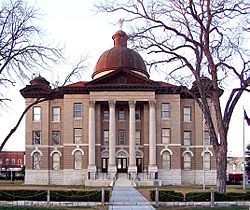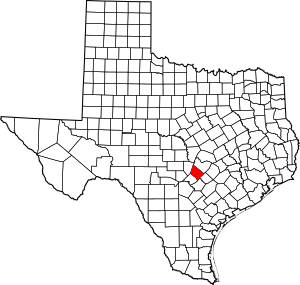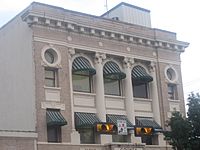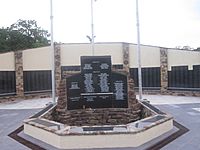Hays County, Texas facts for kids
Quick facts for kids
Hays County
|
|
|---|---|

Hays County Courthouse, built in 1908 using the eclectic style of architecture
|
|

Location within the U.S. state of Texas
|
|
 Texas's location within the U.S. |
|
| Country | |
| State | |
| Founded | 1848 |
| Named for | John Coffee Hays |
| Seat | San Marcos |
| Largest city | San Marcos |
| Area | |
| • Total | 680 sq mi (1,800 km2) |
| • Land | 678 sq mi (1,760 km2) |
| • Water | 1.9 sq mi (5 km2) 0.3% |
| Population
(2020)
|
|
| • Total | 241,067 |
| • Density | 354.5/sq mi (136.9/km2) |
| Time zone | UTC−6 (Central) |
| • Summer (DST) | UTC−5 (CDT) |
| Congressional districts | 21st, 25th, 35th |

Hays County is located on the Edwards Plateau in the U.S. state of Texas. Hays County is part of the Austin-Round Rock metropolitan area. As of the 2020 census, its official population had reached 241,067. The county seat is San Marcos. Hays, along with Comal and Kendall Counties, was listed in 2017 as one of the nation's fastest-growing large counties with a population of at least 10,000. From 2015 to 2016, Hays County, third on the national list, had nearly 10,000 new residents during the year. Comal County, sixth on the list, grew by 5,675 newcomers, or 4.4%. Kendall County, the second-fastest growing county in the nation, grew by 5.16%. As a result of this growth, the counties have experienced new home construction, traffic congestion, and greater demand for public services. Bexar County, which includes San Antonio, grew by 1.75% during the year, but its sheer number of new residents exceeded 33,000.
The county is named for John Coffee Hays, a Texas Ranger and Mexican–American War officer.
Contents
History
- 6000 BC Paleo-Indians were the first inhabitants.
- Archeological evidence at Timmeron site indicated the Tonkawa tribe was involved in agriculture around 1200 AD.
- Father Isidro Félix de Espinosa, Father Antonio de San Buenaventura y Olivares, and Pedro de Aguirre were in an expedition in the area in 1709.
- French-Canadian explorer Louis Juchereau de St. Denis was attacked by Comanches in 1714.
- In 1755, Mission San Francisco Xavier de los Dolores was established among the Apache tribe.
- In 1831, Coahuila y Tejas issued a land grant to Juan Martín de Veramendi, to Juan Vicente Campos in 1832, and to Thomas Jefferson Chambers in 1834.
- The Mexican government issued a land grant to the first Anglo-American settler in the county, Thomas G. McGhee of Tennessee in 1835.
- On March 1, 1848, the legislature formed Hays County from Travis County. The county is named for Tennessee transplant Captain John Coffee Hays of the Texas Rangers. San Marcos was named as the county seat.
- The legislature established Blanco from part of Hays in 1858, but incorporated part of Comal into Hays. Risher and Hall Stage Lines controls 16 of 31 passenger and mail lines in Texas.
- In 1861, voters in the county favored secession from the Union.
- The legislature transferred more of Comal County to Hays County in 1862.
- In 1867, the first cattle drive from Hays County to Kansas occurred.
- International-Great Northern Railroad was completed from Austin to San Marcos in 1880.
- Camp Ben McCulloch, named after a brigadier general, was organized in 1896 for reunions of United Confederate Veterans.
- A teacher’s college, Southwest Texas State Normal School, was established in San Marcos in 1899.
- Wonder Cave opened to the public in 1900.
- The current Hays County Courthouse in San Marcos was erected in 1908. Beaux-Arts style by Architect C.H. Page & Bros.
- The Aquarena Springs tourist site opened in 1928 in San Marcos.
- Lyndon Baines Johnson graduated from Southwest Texas State Teachers College in 1930.
- In 1942, construction of San Marcos Army Air Field began.
- San Marcos Army Air Field was renamed Gary Air Force Base in 1953 to honor Second Lieutenant Arthur Edward Gary, the first San Marcos resident killed in World War II.
- The state legislature resurveyed the Hays and Travis County lines, adding 16,000 acres (65 km2) to Hays County in 1955.
- In 1964, U.S. President Lyndon Johnson announced the establishment of a Job Corps center based at the deactivated Gary Air Force Base.
Geography
According to the U.S. Census Bureau, the county has a total area of 680 square miles (1,800 km2), of which 678 square miles (1,760 km2) are land and 1.9 square miles (4.9 km2) (0.3%) are covered by water.
Major highways
 Interstate 35
Interstate 35 U.S. Highway 290
U.S. Highway 290 State Highway 21
State Highway 21 State Highway 80
State Highway 80
Adjacent counties
- Travis County (northeast)
- Caldwell County (southeast)
- Guadalupe County (south)
- Comal County (southwest)
- Blanco County (northwest)
Demographics
| Historical population | |||
|---|---|---|---|
| Census | Pop. | %± | |
| 1850 | 387 | — | |
| 1860 | 2,126 | 449.4% | |
| 1870 | 4,088 | 92.3% | |
| 1880 | 7,555 | 84.8% | |
| 1890 | 11,352 | 50.3% | |
| 1900 | 14,142 | 24.6% | |
| 1910 | 15,518 | 9.7% | |
| 1920 | 15,920 | 2.6% | |
| 1930 | 14,915 | −6.3% | |
| 1940 | 15,349 | 2.9% | |
| 1950 | 17,840 | 16.2% | |
| 1960 | 19,934 | 11.7% | |
| 1970 | 27,642 | 38.7% | |
| 1980 | 40,594 | 46.9% | |
| 1990 | 65,614 | 61.6% | |
| 2000 | 97,589 | 48.7% | |
| 2010 | 157,127 | 61.0% | |
| 2020 | 241,067 | 53.4% | |
| U.S. Decennial Census 2010 2020 | |||
2020 census
| Race / Ethnicity | Pop 2010 | Pop 2020 | % 2010 | % 2020 |
|---|---|---|---|---|
| White alone (NH) | 92,062 | 121,568 | 58.60% | 50.43% |
| Black or African American alone (NH) | 4,970 | 9,004 | 3.16% | 3.74% |
| Native American or Alaska Native alone (NH) | 502 | 599 | 0.32% | 0.25% |
| Asian alone (NH) | 1,699 | 4,822 | 1.08% | 2.00% |
| Pacific Islander alone (NH) | 104 | 144 | 0.07% | 0.06% |
| Some Other Race alone (NH) | 226 | 1,009 | 0.14% | 0.42% |
| Mixed Race/Multi-Racial (NH) | 2,143 | 11,050 | 1.36% | 4.58% |
| Hispanic or Latino (any race) | 55,401 | 92,871 | 35.26% | 38.52% |
| Total | 157,107 | 241,067 | 100.00% | 100.00% |
Note: the US Census treats Hispanic/Latino as an ethnic category. This table excludes Latinos from the racial categories and assigns them to a separate category. Hispanics/Latinos can be of any race.
2015 Texas population estimate program
As of the 2015 Texas population estimate program, the county's population was 193,963: non-Hispanic Whites, 106,919 (55.1%); non-Hispanic Blacks, 5,860 (3.0%); other non-Hispanics, 6,624 (3.4%); and Hispanics and Latinos (of any race), 74,560 (38.4%).
Communities
Cities (multiple counties)
- Austin (primarily in Travis County)
- Niederwald (partly in Caldwell County)
- San Marcos (county seat) (small parts in Caldwell and Guadelaupe counties)
- Uhland (partly in Caldwell County)
Cities
Village
Census-designated place
Ghost town
- Goforth
Gallery
Education
School districts in Hays County include the San Marcos Consolidated, Dripping Springs Independent, Wimberley Independent, and Hays Consolidated Independent school districts. As of 2020, the county has six high schools, 10 middle schools, and 24 elementary schools.
Higher education in Hays County includes one four-year institution, Texas State University, in San Marcos.
Austin Community College is the designated community college for the whole county. It operates three distance-learning centers that offer basic and early college start classes, along with testing centers for online classes.
Transportation
Major highways
 Interstate 35
Interstate 35 U.S. Highway 290
U.S. Highway 290 State Highway 21
State Highway 21 State Highway 80
State Highway 80
Airport
- San Marcos Regional Airport - general aviation airport without commercial flights
See also
 In Spanish: Condado de Hays para niños
In Spanish: Condado de Hays para niños





